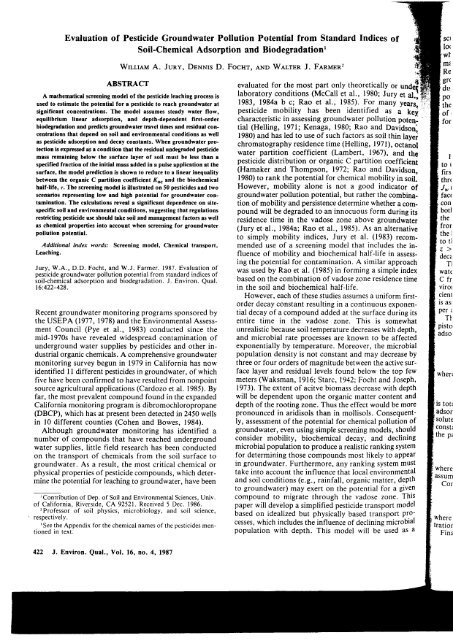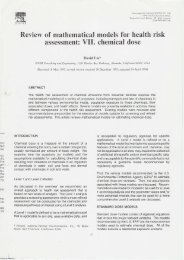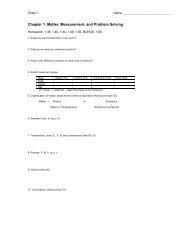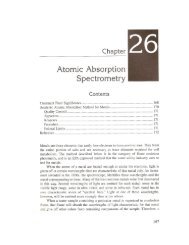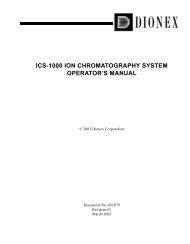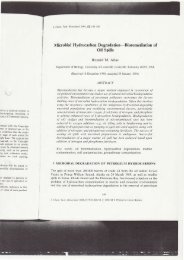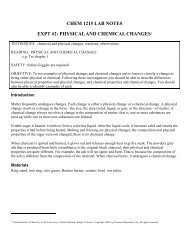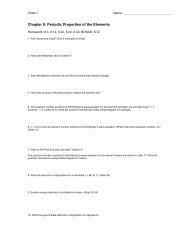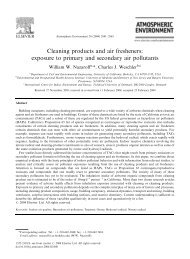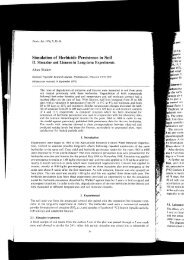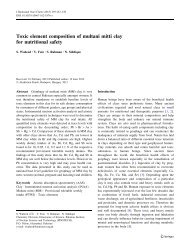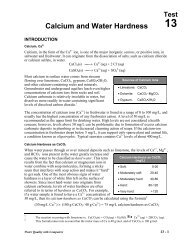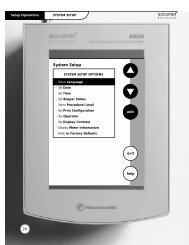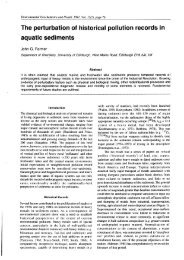Evaluation of Pesticide Groundwater Pollution Potential from ...
Evaluation of Pesticide Groundwater Pollution Potential from ...
Evaluation of Pesticide Groundwater Pollution Potential from ...
You also want an ePaper? Increase the reach of your titles
YUMPU automatically turns print PDFs into web optimized ePapers that Google loves.
<strong>Evaluation</strong> <strong>of</strong> <strong>Pesticide</strong> <strong>Groundwater</strong> <strong>Pollution</strong> <strong>Potential</strong> <strong>from</strong> Standard Indices <strong>of</strong>Soil-Chemical Adsorption and BiodegradationlWrrrnu A. Junv. DsNNrs D. Focsr. eNo Warrrn J. Fanurn'ABSTRACTA mathematical screcning model <strong>of</strong> tbe pesticide leaching process isused to estimate the potential for a pcsticide to rerch groundwrter rtsignificrnt concentrrtions. The model rssumes steady water flow,equilibrium linear adsorption, end depth-dependent first-orderbiodegradation and prcdicts groundwater tnvel times and rcsiduel concenlrrtionsthat depend on soil and environmentel conditions as wellas pesticide edsorption and decay constlnls. When groundwrter protectionis expressed as a condition that the residual undegreded pesticidemass remaining below the surface layer <strong>of</strong> soil must be less thsn aspecified fraclion <strong>of</strong> the initial mass added in a pulse application at thesurfsce, the model prediction is shown to reduce to r linear inequalitybetw€€n the orgrtric C pertition coefficient rKo" and the biochemicrlbalfJife, r. The screening model is illuslrated on 50 peslicides and twoscenrrios represenling low and high potentisl for groundwater contamination.The calculations reveal a significant dependence on sitespecificsoil and environmetrtsl conditions, suggesting that reguletionsrestricting pesticide use should take soil and management factors as wellas chemical properties into iccount when screening for groundwalerpollution potential.Additional index words: Screening model, Chemical transport,Leaching.Jury, W.A., D.D. Focht, and W.J. Farmer. 1987. <strong>Evaluation</strong> <strong>of</strong>pesticide groundwater pollution potentiaI <strong>from</strong> standard indices <strong>of</strong>soil-chemical adsorption and biodegradation. J. Environ. Qual.l6:,422-428.Recent groundwater monitoring programs sponsored bythe USEPA (197"1, l9'78) and the Environmental AssessmentCouncil (Pye et al., 1983) conducted since themid-1970s have revealed widespread contamination <strong>of</strong>underground water supplies by pesticides and other industrialorganic chemicals. A comprehensive groundwatermonitoring survey begun in 1979 in California has nowidentified I I different pesticides in groundwater, <strong>of</strong> whichfive have been confirmed to have resulted <strong>from</strong> nonpointsource agricultural applications (Cardozo et al. 1985). Byfar, the most prevalent compound found in the expandedCalifornia monitoring program is dibromochloropropane(DBCP), which has at present been detected in 2450 wellsin I0 different counties (Cohen and Bowes, 1984).Although groundwater monitoring has identified anumber <strong>of</strong> compounds that have reached undergroundwater supplies, Iittle field research has been conductedon the transport <strong>of</strong> chemicals <strong>from</strong> the soil surface togroundwater. As a result, the most critical chemical orphysical properties <strong>of</strong> pesticide compounds, which determinethe potential for leaching to groundwater, have been'Contribution <strong>of</strong> Dep. <strong>of</strong> Soil and Environmental Sciences, Univ.<strong>of</strong> California, Riverside, CA 92521. Received 5 Dec. 1986.'Pr<strong>of</strong>essor <strong>of</strong> soil physics, microbiology, and soil science,respectively.'See the Appendix for the chemical names <strong>of</strong> the pesticides mentionedin text.evaluated for the most part only theoretically or undeflaboratory conditions (McCall et al., 1980; Jury et al.l1983, 1984a b c; Rao et al., 1985). For many years;pesticide mobility has been identified as a kevcharacteristic in assessing groundwater pollution potential(Helling, l97l; Kenaga, 1980; Rao and Davidson.1980) and has led to use <strong>of</strong> such factors as soil thin laye;chromatography residence time (Helling, l97l), octanolwater partition coefficient (Lambert, 1967), and thepesticide distribution or organic C partition coefficient(Hamaker and Thompson, 1972; Rao and Davidson,1980) to rank the potential for chemical mobility in soil.However, mobility alone is not a good indicator <strong>of</strong>groundwater pollution potential, but rather the combination<strong>of</strong> mobility and persistence determine whether a compoundwill be degraded to an innocuous form during itsresidence time in the vadose zone above groundwater(Jury et.al., 1984a; Rao et al., 1985). As an alternativeto simply mobility indices, Jury et al. (1983) recommendeduse <strong>of</strong> a screening model that includes the influence<strong>of</strong> mobility and biochemical half-life in assessingthe potential for contamination. A similar approachwas used by Rao et al. (1985) in forming a simple indexbased on the combination <strong>of</strong> vadose zone residence timein the soil and biochemical half-life.However, each <strong>of</strong> these studies assumes a uniform firstorderdecay constant resulting in a continuous exponentialdecay <strong>of</strong> a compound added at the surface during itsentire time in the vadose zone. This is somewhatunrealistic because soil temperature decreases with depth,and microbial rate processes are known to be affectedexponentially by temperature. Moreover, the microbialpopulation density is not constant and may decrease bythree or four orders <strong>of</strong> magnitude between the active surfacelayer and residual levels found below the top fewmeters (Waksman, l9l6; Starc, 1942; Focht and Joseph,1973). The extent <strong>of</strong> acitve biomass decrease with depthwill be dependent upon the organic matter content anddepth <strong>of</strong> the rooting zone. Thus the effect would be morepronounced in aridisols than in mollisols. Consequently,assessment <strong>of</strong> the potential for chemical pollution <strong>of</strong>groundwater, even using simple screening models, shouldconsider mobility, biochemical decay, and decliningmicrobial population to produce a realistic ranking systemfor determining those compounds most likely to appearin groundwater. Furthermore, any ranking system musttake into account the influence that local environmentaland soil conditions (e.g., rainfall, organic matter, depthto groundwater) may exert on the potential for a givencompound to migrate through the vadose zone. Thispaper will develop a simplified pesticide transport modelbased on idealized but physically based transport processes,which includes the influence <strong>of</strong> declining microbialpopulation with depth. This model will be used as ascllotwllnzRegr(dupothe<strong>of</strong>forItolfirsthrdecaT]wat(Cfrvirorclenis asper :TTpistoadsois totiadsorsolutconstthe p:whereassumCorwheretratiorFina4ZZJ. Environ. Qual., Vol. 16, no. 4, l9E7
screening tool in several scenarios that span a range <strong>of</strong>local soil and environmental conditions for estimatingwhich compounds may reach groundwater with a residualmass deemed sufficiently high to pose a potential hazard.Representative values for soil properties, depths togroundwater and drainage rates will be combined to producedifferent scenarios that represent low and highpotential for pesticide migration to groundwater. Afterthe model is developed, it will be applied to a number<strong>of</strong> compounds for which sufficient chemical property informationis available.THEORYIn the screening model to follow, each chemical is assumedto undergo linear, reversible, equilibrium adsorption, andfirst-order biochemical decay while moving downwardthrough soil by leaching at a uniform average drainage rate-r,u(m d-'). The soil is divided into three regions: (i) a surracezone (0 < e < t) within which the biological decayionstant p (d-') and the microbial population density E areboth constant; (ii) a lower vadose zone (L < z < H) whereinthe microbial population density is exponentially declining<strong>from</strong> its surface value to a residual value Er. In this zonethe biological decay constant is assumed to be proportionalto the relative microbial population; and (iii) a deep zonez > H where both the microbial population density anddecay constant are at residual constant values.The soil is characterized by uniform values <strong>of</strong> volumetricwater content 0, soil bulk density Qb (kg m-') and organicC fraction /o.. Each chemical is characterized by two environmentalfate properties: the organic C partition coefficient,Ko. (m' kg -') and the biochemical halflife r (d), andis assumed to be applied in a single application <strong>of</strong> mass Moper area to the surface dt / : 0.The mass balance equation for a chemical moving bypiston flow (no dispersion or diffusion) while undergoingadsorption and first-order decay may be written as;here________:_]Crr r,_: }ct' !|(al dzi p(Z)Cr:0 tllCr = etC, + |CL 121is total solute concentration (g m-' soil), C" (g kg-' soil) isadsorbed concentration, CL (g m-r solution) is dissolvedsolute concentration, and p(7) (d-') is the biochemical rateconstant. Linear, equilibrium adsorption is represented bythe partitioning relationCs : KpCl : f*Ko"Cr I3lwhere ,(2 (m' kg-') is the distribution coefficient. Thisassumption is most suited to nonionic organic chemicals.Combining Eq. [2] and [3] givesCr : (quf.,Ko. * O)CL = RtCt I4lwhere R1 is the ratio <strong>of</strong> total to dissolved chemical concentration(Jury et al., 1983).Finally, inserting Eq. [4] into Eq. [] gives]Cr ]Cru+vtilp(z)c7:Qt5lwhere vB : Jn/Rt is the effective solute velocity.Equation [5] will be solved for the assumption <strong>of</strong> zero initialsolute in soilCr@,2) = o[6a]and for the case <strong>of</strong> a single flux <strong>of</strong> mass Mo applied to thesoilatl:0Js@,t) = VzCr(o,t) : M"6(t)t6blwhere "I" is the solute flux and 6(/) is the Dirac 6-function.The solution to Eq. [5] and [6], which may be easily obtainedusing Laplace transforms, is given byCflz,t)Mo 1 I tz -r= vr.^n[ ,, ]o r?)dzl 6(t - z/Vd I7lThe amount <strong>of</strong> mass M(t) contained in the pulse as it travelsthrough the soil is given byf@M(t) = lo CrQ,t)dz= Mo ..xp l- +,1{'' r HE : Eo exp [-,y(I/p = llo Er/Es :p,r.- L)l = E,[0a]tlOblll lalt1 lblIr2alll2blJ. Environ. Qual., Vol. 16, no. 4, l9E7 4?3
Focht and Joseph (1973) measured a depth constant <strong>of</strong>approximately y = 3 m-' on two arid zone soils.With the depth dependence p(z) specified in Eq. [10b] to[2b], Eq. [9] may be explicitly solved for M(a) in terms<strong>of</strong> the soil, environmental, and chemical parametersspecified in the model. As the solute pulse reaches depth zat time t : z/Ve the fraction M(z\/M" <strong>of</strong> the mass appliedat the surface that has not degraded is given byl.Surfacezone0
T.torlhce'lyry:jTable 2. Environmental fate properties <strong>of</strong> pesticide chemicalsused in screening model calculations {adapted <strong>from</strong> Jury etal., 1984; Rao et al., 1985; and Wilkerson et aI., 1984).ChemicaltAlachlorAldicarbAtrazineBromacilCaptanCarbarylCab<strong>of</strong>uranChlordaneChlorothalonilChlorpyrifosChlorthal dimethylCyanazine2,4-DDBCPDDTDiazinonDicambaDichloropropeneDieldrinDisulfotonDiuronEDBEPTCEthoprophosFenrmiphosFon<strong>of</strong>osHeptacNorLindaneLinuronMalathionMethyl parathionMetolachlorMetribuzinMonutonNapropamideOxamylParathionPenthachlorophenolPhoratePicloramPrometrynPropachlorPropylene dichlorideSimzine2,4,5-TTerbacilToxaphenettiallateTrifluralinTable 3. Residual mass percent and travel time to H = 3 mfor pesticides leached under the low pollution potentialscenario <strong>of</strong> Table l.K@ T,,,<strong>Pesticide</strong>t Residual mass percent Tirne to reach Z = Hm. kg-'r.2008 - 0l3.600E - 021.6008 -0r7.200E -023.300E - 022.290E -0r2.800E -023.800t + 011.380-g + 006.070.4 + 004.000-0 + 001.680t -012.000E -027.0008 -022.4OOE +028.500.8 - 022.2008 -036.8008 -021.2008 + 011.600-E + 003.800.8 - 014.400E -022.8008-01r.2008 -01r.710.9 - 0r6.800t-022.4008 +011.3008+008.630.S - 01i.796t + 005.100t + 001.810E - 0l2.4008 -021.8008 - 013.000r-016.0008 - 031.100E + 0l1.429E +0r6.6008-014.8008 - 026.100t-014.200I' -014.300E -021.400E - 018.000t - 024.r00E -022.1008 + 013.600-E + 007.300E + 00d1.800t + 01?.000E + 0i6.4008 + 013.5008 +023.000, + 002.2OOE +Or4.000.8 + 0r3.500E + 037.000,E' + 016.300, + 011.0008 + 021 350-0 + 0l7. l00t + 002.250E +023.837' + 033.2008 +OL1.400t +011.600t + 0r8.6808 + 025.0008 + 003.2808+023.650t + 033.000.9+015.000t+01r.0008+016.000.8+0r2.0008 + 032.6608 +027.500.E +011.000.p + 001.500r+014.2008 + 013.700.E + 0l1.660.8+027.000-D + 006.000t + 001.800.E + 0r4.800-8 +018.200' + 01r.000.9 +026.000.9 + 017.000, + 005.500t + 01?.500t+013.300,8 +015.000.9 + 0r9.000, + 001.000,9+021.3208 +02I Scientific names for most <strong>of</strong> the compounds may be found in HerbicideHondbooh <strong>of</strong> the Weed Science Society <strong>of</strong> Ameica (WSSA, 19831 or thecunent edition <strong>of</strong> Fum Chemicals Handbooh {Meister Publishing Co.,1987).0, and the values given in Tables 3 and 4 representheresidual value M/Mo attained at z - I/ (here 3 m).for illustration in Fig. I are plots <strong>of</strong> the fraction<strong>of</strong> the applied mass (Eq. [14]) that has not degraded vs.depth for three chemicals for the high pollution potencase,Dramatic differences are seen in the residual values bethelow and high pollution potential cases. For exlmple,only three <strong>of</strong> the 50 chemicals reach 3 m with>0.0190 <strong>of</strong> the applied mass in the low pollution, whereas 23 <strong>of</strong>the 50 have values above this levelthe high pollution potential case. In the latter case,le and persistent chemicals such as EDB reach 3 mh nearly the same mass at which they were added atsurface.CaptanCarbarylChlordaneChlorphyrifosDDTDiazinonDieldrinDisulfotonEPTCFenamiphosHeptachlorLindaneLinuronMalathionMethyl parathionNapropamideOxamylParathionPentachlorophenolPrometrynPhoratePropachlorTriallateTrifluralinAlachlor2,4-D2,4,5-"1Chlorthal dimethylMetolachlorChlorothalonilDichloropropeneToxapheneAtrazineCyanazineEthoprophosSimzineFon<strong>of</strong>osDiuronMonuronDicambaTerbacilCab<strong>of</strong>uranPropylene dichlorideMetribuzinAldicarbPicloramDBCPBromacilEDBt See Table 2 footnote.7a0.000.000.000.000.000.000.000.000.000.000.000.000.000.000.000.000.000.000.000.000.000.000.000.000.000.000.000.000.000.000.000.000.000.000.000.000.000.000.000.000-000.000.000.000.000.000.020.2668.02yrr0.1I2r0.213r4.05l 837.821.42 594.7348.6oJ.a39.95 186.5283.8189.4390.9I 104.567.84.32 378.8145.53 089.3t34.793.7780.5I 5?9.635.4na20.3866.942.1301.0t7.74 538.537.639.328.9t7.785.14r.9I 1.99.012.38.210.818. Ir8.6tz.5Among the pesticides predicted to move below thebiologically active zone while retaining a substantial fraction<strong>of</strong> the applied mass are a number <strong>of</strong> compounds thathave been found in groundwater, including widespreadreported contamination by EDB, DBCP, and aldicarb(Cohen et al., 1984). Of the 17 compounds in Table 4showing l9o or greater residual mass under the high pollutionpotential scenario, only dicamba and terbacil did notappear on the lists <strong>of</strong> observed groundwater contaminantsreported in Rao et al. (1985) and Wilkerson et al. (1984).Conversely, <strong>of</strong> the 26 compounds predicted to decaybelow 0.0190 <strong>of</strong> the initial mass, only two (alachlor andparathion) appeared on the list <strong>of</strong> contaminants publishedin Rao et al. (1985) and seven (chlorthal dimethyl, prometryn,alachlor, carbaryl, dieldrin, cyanazine, andheptachlor) were reported as observed in groundwater byWilkerson et al. (1984). Of these seven compounds, onlyalachlor and cyanazine were detected more than once.J. Environ. Qual., Vol. 16, no. 4, l9E7 425
Table 4. Besidual maaa peroent and travel time to 11 = 3 m <strong>of</strong>pesticides leached under the high pollution <strong>Potential</strong>scenario <strong>of</strong> Table l.<strong>Pesticide</strong>tChlorphyrifosDDTDisulfotonMalathionMethyl paathionPuathionPentachlorophenolPropachlorTrifluralinToxapheneChlortha.l dimethylTriallateChloroihalonilCaptarFenamiphosCyanazineDieldrinHeptachlorInuronCarbarylChlordanePrometrynEFrfCPhorateAlachlor2,4-DDichloropropeneOxamylLindaneMelolachlorNapropamideDiazinon2,4,5-TEthoprophosAtrazineSimazineDicambaFon<strong>of</strong>osMetribuzinCab<strong>of</strong>uranTerbacilPropylene dichlorideMonuronDiuronAldicarbPicloramDBCPBromacilEDBf See Table 2 footnote.Residual massD€rcentTime to reach Z = Hyr137.25 400.136.64 r.0I 15.3248.11r9 \10.0164.8473.190.681.631 .61.34.44.4270.6540.520.05.8855.514.36.915.4J.JTt.02.10.729.84.7na2.53.34.20.62.11.11.21.51.64.69.1t.4t.72.22.21.6The simplicity <strong>of</strong> the screening model, Eq. [5], allowedthe criteria discussed in Eq. [6] to be reduced to a linearinequality equation between Ko. and z. Figure 2 presentsa plot <strong>of</strong> Ko. vs. r for each <strong>of</strong> the 50 chemicals presentedin Table 2 together with two lines representing the boundary<strong>of</strong> the inequality expressed in Eq. [7] for the lowand high pollution potential scenarios. Because the graphin Fig. 2 is on a logarithmic scale, the linear relationshipbetween Ko. and / in Eq. [7] appears to be curvilinearuntil ar > b. The condition implied by the inequality Eq.[7] divides the Ko"-r plane into two regions. Those compoundsthat do not satisfy the inequality test appear inthe lower right-hand side (labeled"high risk region") <strong>of</strong>the plane bisected by the line, whereas the compoundsthat satisfy the inequality appear in the upper left-handVo0.000.000.000.000.000.000.000.000.000.000.000.000.000.000.000.000.000.000.000.000.000.000.000.000.000.000.010.020.040.040.060.400.600.970.992.983.848.257t.47I 1.52r 1.7613.4913.9614.0824.2730.7050.7064.0396.98FRFCTIONRL }1HSS REI,IRINING.AgSl -Setl .Ol .l2.. -D BTRAZ INE---{{ELDICRRBFig. l. Residual mass fractions remaining in an applied puls€ lo?three chemicals lerching to groundwater.part <strong>of</strong> the graph (labeled"low risk region"). Althoughthis graph contains the same information as Tables 3 and4, it has the advantage <strong>of</strong> allowing a preliminary assessment<strong>of</strong> the pollution potential <strong>of</strong> new compounds invarious scenarios merely by inserting them in their properplace in the Ko.-r plane.It should be emphasized that this screening procedureis only qualitative and rests on a number <strong>of</strong> assumptionsnot likely to be perfectly met under natural conditions.For example, there is a growing body <strong>of</strong> evidence thatat least part <strong>of</strong> a pesticide application to the soil undernatural conditions may not adsorb as strongly aspredicted by Eq. [3], and hence will move more rapidlythrough the soil than estimated in this model (Ballard,l97l;Smith and Willis, 1985; Jury et al., 1986a, b). Thus,the high pollution potential condition described in thispaper refers only to estimating the hazard <strong>of</strong> chemicalsthat adsorb in accordance with the linear equilibriummodel described above. This is compounded by using aconstant organic C fraction/o. for all zones even thoughmicrobial biomass is assumed to be decreasing below thesurface zone. If focdecreases below the surface layer, thetravel time through the transition zone will increase andthe fractional mass remaining for ail compounds will increase.Moreover, even for those compounds that do obeythe linear equilibrium and first-order decay assumptionsmade in this model, the experimental values for theirbenchmark parameters Ko. and r may be highly uncertain.For example, many <strong>of</strong> the compounds on the listare quite near the dividing line <strong>of</strong> the high pollutionpotential scenario in Fig. 2. Given that both thelrbiochemical half-life and organic C partition coefficientmay be uncertain by a significant amount, they may wellbelong on the other side <strong>of</strong> the graph <strong>from</strong> where theyare currently placed. For exlmple, the chemicalchlorothalonit nas naa Ko. values repoited between 0'3and 2.9 m' kg-' and r values reported between 45 ana90 d (Wilkerson et al., 1984) This range <strong>of</strong> values tsrepresented in Fig. 2 as a rectangle centered ontheaverageII!IV?Ire€dr
'-+{lforrgh.ndrssinrotre)nsns.ratlerasJlvrd,US'hisalsimgargh:helhendin-)ey)nseirrnlistoneir3nt'ellreycal).3ndisrgeoeo;UrHr<strong>of</strong>tIJoLOH POLLUTIONHIGH POLLUTIONPOTENTINPOTENTIFIL --__-__-oo-#-BIOCHET,IICFIL HRLF LIFELOH RISK REGIONoz/oz/HIGH RISK REGIONFig. 2. Plots <strong>of</strong> (Koc, z) for 50 p€sticides, together with the criterionrequiring reduction <strong>of</strong> surface concentrstion by a factor <strong>of</strong> l0 000before groundwater is reached for the high pollution potential(dashed line) and low pollution potential (solid line) scenariosdefinedTable l. Compounds to the right <strong>of</strong> the line are consideredto be a groundwater risk. Rectangle defines the parameteruncertainly <strong>of</strong> chlorothalonil.values. Thus, this chemical is well within the low riskregion if average values <strong>of</strong> its parameters are used, butdrops into the high risk region if the lowest reported Kocand highest r values are used. Comparable or greateruncertainty about values <strong>of</strong> (o. and z is to be expectedfor many <strong>of</strong> the compounds in widespread use today (Raoand Davidson, 1980).It should also be emphasized that the mass fractionsused to estimate pollution potential are derived <strong>from</strong>values attained at the time the compounds reach theresidual zone <strong>of</strong> 3 m. In some cases the more stronglyadsorbed compounds have appreciable residence timesabove that depth. For example, the pesticide lindane,because <strong>of</strong> its long half-life r : 266 d, lies in the highrisk region <strong>of</strong> the high pollution scenario (Fig. 2).However, its travel time Is : H/Vn to the 3-m depthis nearly 20 yr for the conditions given in Table l. Thus,it will require significant periods <strong>of</strong> time after applicationfor compounds like lindane to ever be detected ingroundwater at great depths below the surface.Finally, several <strong>of</strong> the extreme conditions characteristic<strong>of</strong> transient water inputs to the surface may be misrepresentedby the steady-state model used in this paper.For example, the high pollution potential drainage condition<strong>of</strong> J* : I m yr-' may in some climates have asignificant contribution <strong>from</strong> a few large storms thatcould rapidly leach compounds below the biologically activesurface zone. In this case it would be more appropriateto use a higher value <strong>of</strong> -/r, perhaps representinga seasonal flux rate, to determine the leaching hazard.CONCLUSIONSThe calculations presented above illustrate the significantrole that soil and environmental factors play in determiningwhether a pesticide will reach groundwater after/I J"{--"oo(d)application to the soil surface. Even for a given locationand conditions, however, uncertainty in the values ol adsorptionand decay parameters may limit the use <strong>of</strong> amodel for making regulative decisions, unless the uncertaintyis figured into the decision making process.Although the model presented above may be useful inclassifying compounds for pollution potential, it shouldonly be the first step in a decision toward regulation.Much more experimental data is needed to assess thevalidity <strong>of</strong> the assumptions <strong>of</strong> models such as the one usedabove, when representation <strong>of</strong> the field environment isintended.Despite its shortcomings, however, the screening modelapproach may be very useful in establishing a standardfor interpreting observations <strong>of</strong> contaminants in groundwater.Since there are modes <strong>of</strong> entry for pesticide migrationinto groundwater that do not result <strong>from</strong> agriculturaldrainage, such as migration within an immiscible solventleaking <strong>from</strong> a storage tank, the model predictions maybe taken as a guideline for expected behavior under normalapplication and migration. Then, if a compound islocated in groundwater where it is predicted to have virtuallyno chance <strong>of</strong> migrating there with agriculturaldrainage, this information could trigger a reexamination<strong>of</strong> the consensus chemical adsorption and biodegrationvalues, as well as a follow up investigation <strong>of</strong> alternatemodes <strong>of</strong> entry in the vicinity <strong>of</strong> the observation.ACKNOWLEDGMENTThis research was sponsored in part by the Univ. <strong>of</strong> CaliforniaRiverside Toxic Substances Research and Training Program.APPENDIXThe proper chemical names for the compoundsmentioned in the textCommon nameAldicarbDBCPEDBDicambaTerbacilAlachlorParathionChlorthal dimethylPrometrynCarbarylDieldrinCyanazineHeptachlorChemical name2-methyl-2(methylthio) propionaldehyde0-methylcarbamoyl oxime1,2 dibromo-3-chloropropaneI ,2-dibromoethane3,6-dichloro-2-methoxybenzoic acid3 - t e r t -butyl- 5-chloro-6-met hylu raci I2-chloro-2',6'-diethyl-N-(methoxymethyl)acetanilide0,0-diethyl 0-(4-nitrophenyl) phosphorodithioatedimethyl tetrachloroterephthalate2,4-bis-(isopropylamino)-6-(methylthio)-s-triazinel-napthyl methylcarbamate1,2,3,4,10,1 0-hexachloro-6,7-epoxy,1,4,4a,5,6,7,8,8a-octahydr o-1,4-e nd o -exo-5,8-dimethanonaphthalene2-chloro-4-( I -cyano- I -methylethylami no)-6-ethylamino-s-t riazine1,4,5,6,7,8,8-heptachloro -3a,4,'7,7 a-tetrahvdro-4.7-methanoindeneJ. Environ. Qual., Vol. 16, no. 4, l9E7 427
sen'CoashitGrirLar.95REFERENCESBallard, T.M. l97l . Role <strong>of</strong> humic carrier substances in DDT movementthrough forest soil. Soil Sci. Soc. Am. Proc. 35:146-147.Cardozo, C.L., S. Nicosia, and J. Troiano. 1985. Agriculturalpesticide residues in Calfiornia well water: Development and summary<strong>of</strong> a well inventory data base for non-point sources. CaliforniaDepartment <strong>of</strong> Food and Agriculture, Sacramento.Cohen, D.8., and G.W. Bowes. 1984. Water quality and pesticides:A California risk assessment program. California State WaterResearch Control Board, Sacramento.Cohen, S.2., S.M. Creeger, R.F. Carsel, and C.G. Enfreld. 1984.<strong>Potential</strong> for pesticide contamination <strong>of</strong> groundwater resulting<strong>from</strong> agricultural uses. p.297-325.In R.F. Krueger and J.N.Seiber (ed.) Treatment and disposal <strong>of</strong> pesticide wastes. ACSSymp. Series no.259. American Chemical Society, Washington,DC.Focht, D.D., and H. Joseph. 1973. An improved method for theenumeration <strong>of</strong> denitriying bacteria. soil sci. soc. Am. Proc.3'1:698-699.Hamaker, J.W., and J.M. Thompson. 1972. Adsorption. p.49-144. In C.A.l. Goring and J.W. Hamaker (ed.) Organicchemicals in the soil environment. Marcel Dekker, Inc., NewYork.Helling, C.S. 1971. <strong>Pesticide</strong> mobility in soils. III. Influence <strong>of</strong> soilproperties. Soil Sci. Soc. Am. J. 35:743-748.Jury, W.A., W.F. Spencer, and W.J. Farmer. 1983. Behaviorassessment model for trace organics in soil. l. Model description.J. Environ. Qual. 12:558-564.Jury, W.A., W.J. Farmer, and W.F. Spencer. 1984a. Behaviorassessment model for trace organics in soil. lI. Chemicalclassification parameter sensitivity. J. Environ. Qual. l3:467-572.Jury, W.A., W.F. Spencer, and W.J. Farmer. 1984b. Behaviorassessment model for trace organics in soil. III. Application <strong>of</strong>screening model. J. Environ. Qual. l3:573-579.Jury, W.A., W.F. Spencer, and W.J. Farmer. 1984c. Behaviorassessment model for trace organics in soil. IV. Review <strong>of</strong> experimentalevidence. J. Environ. Qual. l3:580-586.Kenaga, E.E. 1980. Predicted bioconcentration factors and soilsorption coefficients <strong>of</strong> pesticides and other chemicals. Ecotox-icol. Environ. Saf. 4:26-38.Lambert, S.M. 1967. Functional relationships between sorptioosoil and chemical structures. J. Agric. Food Chem.'15:572-5iMcCall, P.J., R.L. Swann, A. Laskowski, S.M. Uneer. Unger, S.i S,Vrrona, and H.J. Dishburger. 1980. Estimation <strong>of</strong> chemimobility in soil <strong>from</strong> liquid chromatographic retentatives.Environ. Contam. Toxicol. 24:19O-195.Meister Publishing Co. 1987. Farm Chemicais Handbook. 73rdMeister Publishing Co., Willoughby, OH.Pye, V., R. Patrick, and J. Quarlcs. 1983. Croundwater contamition in the United States. University <strong>of</strong> Pennsylvania p[6frPhiladelphia. r rrrr4uLrPrrrq, {.(Rao, P.S.C, and J.M-. Davidson. 1980. Estimation <strong>of</strong> pesticiddretention and transformation parameters required in nonpoinllsource pollution models. p.23-61 ..Iz M.R. Overcash and J.M.""Davidson (ed.) Environmental impact <strong>of</strong> nonpoint source pollu-ltion. Ann Arbor Science Publ., Ann Arbor, ML .:Rao, P.S.C, A.C. Hornsby, aqd R.E. Jessuq. 1985. Indices fonranking the potential tbr pesticide contamination <strong>of</strong> groundwater;iProc. Soil Crop Sci. Soc. Fla. 44:l-8. ::]Smith, S., and G.H. Willis. 1985. Movement <strong>of</strong> pesticides in soil ..columns as affected by anhydrous ammonia. Environ. Todcol.Chem. 4:425-434.Starc, S.A. 1942. Mikrobiologische Untershuchunger einiger podsoligierBoden Kroatiens. Arch. Mikrobiol. 12:329-352.U.S. Environmental Protection Agency (USEPA). 1977. Wastedisposal practices and their effects on groundwater. Report toCongress, Washington, DC. USEPA, Washington, DC.U.S. Environmental Protection Agency. 1978. Surface impoundmentsand their effects on groundwater quality in the US-Apreliminary survey. EPA/9-78-004. USEPA, Washington, DC.Waksman, S.A. 1916. Bacterial numbers in soils at different depths,and in different seasons <strong>of</strong> the year. Soil Sci. l:363-380.Weed Science Society <strong>of</strong> America (WSSA). I 983. Herbicide handbook<strong>of</strong> the Weed Science Society <strong>of</strong> America. 5th ed. WSSA,Champaign, IL.Wilkerson, M., D. Kim, and M. Nodell. 1984. The pesticide groundwaterprevention act: Setting specific numerical values. Calif,Dep. <strong>of</strong> Food and Agric. Rep. September 1984. State <strong>of</strong> California,Dep. <strong>of</strong> Food and Agriculture, Sacramento, CA.llwlot(clrpectln4tbaprl'fillcatsulcal,lsdetsullcreithsorgplerHorfectl5:


